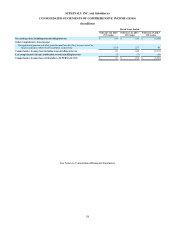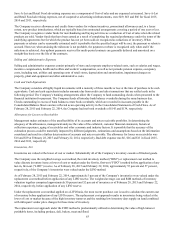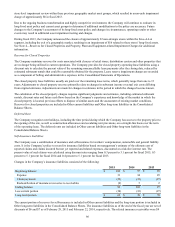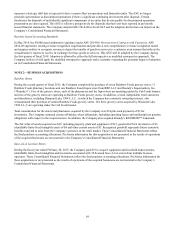Albertsons 2015 Annual Report Download - page 65
Download and view the complete annual report
Please find page 65 of the 2015 Albertsons annual report below. You can navigate through the pages in the report by either clicking on the pages listed below, or by using the keyword search tool below to find specific information within the annual report.63
Save-A-Lot and Retail Food advertising expenses are a component of Cost of sales and are expensed as incurred. Save-A-Lot
and Retail Food advertising expenses, net of cooperative advertising reimbursements, were $69, $63 and $86 for fiscal 2015,
2014 and 2013, respectively.
The Company receives allowances and credits from vendors for volume incentives, promotional allowances and, to a lesser
extent, new product introductions, which are typically based on contractual arrangements covering a period of one year or less.
The Company recognizes vendor funds for merchandising and buying activities as a reduction of Cost of sales when the related
products are sold. Vendor funds that have been earned as a result of completing the required performance under the terms of the
underlying agreements but for which the product has not yet been sold are recognized as reductions of inventory. When
payments or rebates can be reasonably estimated and it is probable that the specified target will be met, the payment or rebate is
accrued. However, when attaining the milestone is not probable, the payment or rebate is recognized only when and if the
milestone is achieved. Any upfront payments received for multi-period contracts are generally deferred and amortized on a
straight-line basis over the life of the contracts.
Selling and Administrative Expenses
Selling and administrative expenses consist primarily of store and corporate employee-related costs, such as salaries and wages,
incentive compensation, health and welfare and workers' compensation, as well as net periodic pension expense, occupancy
costs, including rent, utilities and operating costs of retail stores, depreciation and amortization, impairment charges on
property, plant and equipment and other administrative costs.
Cash and Cash Equivalents
The Company considers all highly liquid investments with a maturity of three months or less at the time of purchase to be cash
equivalents. Cash and cash equivalents includes amounts due from credit card sales transactions that are settled early in the
following period. The Company’s banking arrangements allow the Company to fund outstanding checks when presented to the
financial institution for payment. The Company funds all intraday bank balance overdrafts during the same business day.
Checks outstanding in excess of bank balances create book overdrafts, which are recorded in Accounts payable in the
Consolidated Balance Sheets and are reflected as an operating activity in the Consolidated Statements of Cash Flows. As of
February 28, 2015 and February 22, 2014, the Company had net book overdrafts of $145 and $134, respectively.
Allowances for Losses on Receivables
Management makes estimates of the uncollectibility of its accounts and notes receivable portfolios. In determining the
adequacy of the allowances, management analyzes the value of the collateral, customer financial statements, historical
collection experience, aging of receivables and other economic and industry factors. It is possible that the accuracy of the
estimation process could be materially impacted by different judgments, estimations and assumptions based on the information
considered and result in a further deterioration of accounts and notes receivable. The allowance for losses on receivables was
$18 and $19 at February 28, 2015 and February 22, 2014, respectively. Bad debt expense was $6, $16 and $11 in fiscal 2015,
2014 and 2013, respectively.
Inventories, Net
Inventories are valued at the lower of cost or market. Substantially all of the Company’s inventory consists of finished goods.
The Company uses the weighted average cost method, the retail inventory method (“RIM”) or replacement cost method to
value discrete inventory items at lower of cost or market under the first-in, first-out (“FIFO”) method before application of any
last-in, first-out (“LIFO”) reserve. As of February 28, 2015 and February 22, 2014, approximately 55 percent and 57 percent,
respectively, of the Company’s inventories were valued under the LIFO method.
As of February 28, 2015 and February 22, 2014, approximately 5 percent of the Company’s inventories were valued under the
replacement cost method before application of any LIFO reserve. The weighted average cost and RIM methods of inventory
valuation together comprised approximately 50 percent and 52 percent of inventory as of February 28, 2015 and February 22,
2014, respectively, before application of any LIFO reserve.
Under the replacement cost method applied on a LIFO basis, the most recent purchase cost is used to calculate the current cost
of inventory before application of any LIFO reserve. The replacement cost approach results in inventories being valued at the
lower of cost or market because of the high inventory turnover and the resulting low inventory days supply on hand combined
with infrequent vendor price changes for these items of inventory.
The replacement cost approach under the FIFO method is predominantly utilized in determining the value of high turnover
perishable items, including produce, deli, bakery, meat and floral.
























